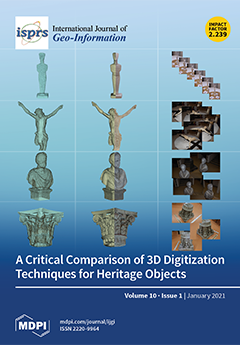The satellite-retrieved Aerosol Optical Depth (AOD) is widely used to estimate the concentrations and analyze the spatiotemporal pattern of Particulate Matter that is less than or equal to 2.5 microns (PM
2.5), also providing a way for the related research of air pollution. Many studies generated PM
2.5 concentration networks with resolutions of 3 km or 10 km. However, the relatively coarse resolution of the satellite AOD products make it difficult to determine the fine-scale characteristics of PM
2.5 distributions that are important for urban air quality analysis. In addition, the composition and chemical properties of PM
2.5 are relatively complex and might be affected by many factors, such as meteorological and land cover type factors. In this paper, an AOD product with a 1 km spatial resolution derived from the Multi-Angle Implementation of Atmospheric Correction (MAIAC) algorithm, the PM
2.5 measurements from ground sites and the meteorological data as the auxiliary variable, are integrated into the Modified Support Vector Regression (MSVR) model that proposed in this paper to estimate the PM
2.5 concentrations and analyze the spatiotemporal pattern of PM
2.5. Considering the relatively small dataset and the somewhat complex relationship between the variables, we propose a Modified Support Vector Regression (MSVR) model that based on SVR to fit and estimate the PM
2.5 concentrations in Hubei province of China. In this paper, we obtained Cross Correlation Coefficient (R²) of 0.74 for the regression of independent and dependent variables, and the conventional SVR model obtained R² of 0.60 as comparison. We think our MSVR model obtained relatively good performance in spite of many complex factors that might impact the accuracy. We then utilized the optimal MSVR model to perform the PM
2.5 estimating, analyze their spatiotemporal patterns, and try to explain the possible reasons for these patterns. The results showed that the PM
2.5 estimations retrieved from 1 km MAIAC AOD could reflect more detailed spatial distribution characteristics of PM
2.5 and have higher accuracy than that from 3 km MODIS AOD. Therefore, the proposed MSVR model can be a better method for PM
2.5 estimating, especially when the dataset is relatively small.
Full article





